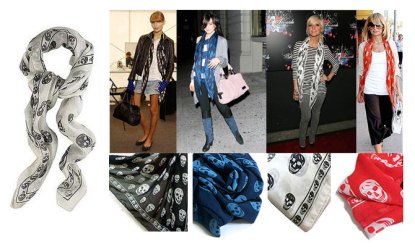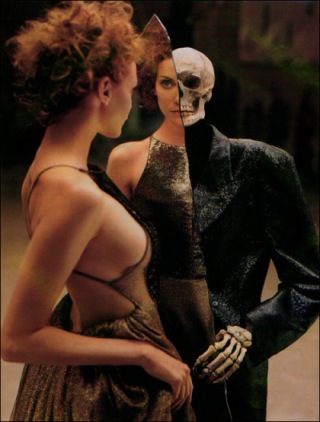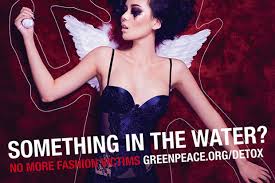Fashion is a serial killer disguised as a prince charming. Young girls grow up thinking that, one day, they will have a closet full of pretty dresses and killer (literally) shoes. Well! Think twice before you tell this story. It’s a bloody fairytale with a morbid ending. The main protagonist, Fashion, is the cruel and destructive character. He has a rare condition called “split personality”. Death is his dark side. Although he seems fine, he creeps around, proud and ready to strike. He makes you feels good, you adore him, you even cherish him. Then you become obsessed with him. Because of his changing nature, he constantly feeds you with renewed pleasure. In reality, it is much more complex. It is a toxic nightmare. Fashion is lethal.
Death seemed to have always teased Fashion. In literature, they were caught in a very intellectual conversation (Giacomo Leopardi in “Dialogue Between Fashion and Death”, 1824). Then, Death appeared in trends. Candidly, Fashion tends to play with symbols and representation of death (Alexander McQueen’s skull).
Moreover, high-end Fashion enjoys advertising Death in campaigns (Zombie Boy as the face of Thierry Mugler’s, 2011).
Finally, “La Mort” inspires publications, which design influential fashion editorials (Richard Avedon for The New Yorker, 1995)
This is all ironic. Death’s implication in fashion is much more evil. Put aside appearances and think health implications. It goes beyond Vogue’s pages or Zara’s window displays. Fashion (manufacture) is addicted to hazardous chemicals.
There are initiatives fighting this plague. In academics, Dr Alison Matthews David’s research is groundbreaking. It depicts the intersections between dress and medical histories. It explores the theme of clothing causing bodily harm to its makers and wearers by leaching toxins, transmitting disease (skin cancer), and causing accidents (fire). Initiatives have also been taken at the political level with NGOs such as Green Peace launching the Greenpeace’s Detox Campaign (2012), which exposed textile-manufacturing facilities using toxic chemicals and water pollution.
The truth is: clothes we wear are not just patterns cut and sewn together to make a garment, their story is much more macabre. There is a powerful tension between the two realms of fashion and death. Sadly, the victims are humans.
Questions remain unanswered: Is being aware of those tensions sincerely affects our relation with fashion? Must governments act to regulate the fashion industry? Are we ready to change our way of consuming fashion? What if Fashion had an incurable mental disorder?




I enjoy the poetic element to your description of the relationship one has with fashion. You pose some important questions at the end of your post: “Must governments act to regulate the fashion industry? Are we ready to change our way of consuming fashion?” I would be happy to write an open letter to congress with the class. You ask “What if Fashion had an incurable mental disorder?” Could you elaborate?
Thank you Stephanie for your comment.
Yes. I think fashion should be a matter of state. It is such an important part of the economy, and it impacts so many sectors. Michelle Obama wears fashion. She should be aware of the implication.
In my opinion, fashion plays on two fronts. When I talk about mental disorder, metaphorically, I think about schizophrenia and bipolarity, or as I mentioned this “split personality” character. I’m also thinking about paraphilias such as fetishism.